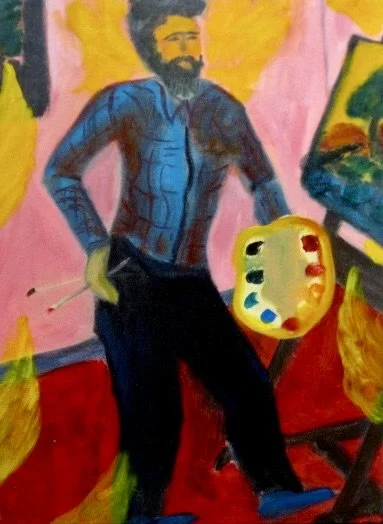Dancing With Angels
In abstraction, everyone gets to participate in the creative process. Viewers see the art, then feelings arise from the shapes and colors. These feelings, then begin to trigger memories and associations which are a catalyst for our mind to absorb shapes within the painting. From there, the viewer ends up creating their own identifications with the forms and colors, thereby both participating in the artist’s vision and creating their own story. Thus the dance continues within the creative process!
I moved to Santa Fe in 1982 from NYC. As I drove down the Old Santa Fe Trail, tears welled in my eyes as I felt I had returned home! I began painting formally somewhat later than most other artists because it was not something I took seriously when I was young. As a result, I am essentially self-taught (although I studied with Alexander Zarick) and taken many classes, I believe that whether you attend art school or not, the true artist has to be self-taught. You can learn about the technical aspects of making art, and that is the value of art school. But, in the long run (and for the long run) we all must explore the various medium for years so that we can meld who we are with our chosen medium. Then, the flow of creativity can become personal, in a very impersonal way, for both the artist and viewer.
Like many artists, I use the word “abstract” quite often because that is my preference for expressing what I do. Yet, I use it with some reservation because my feelings about my work and the work of others who may have a similar interest, cannot and should not, be classified within a category. It seems to me that abstraction is discussed like all other styles of painting as a way of grouping works of art into one category, much like we have done with impressionism, cubism, modernism and all the other isms in the art world and in life. Those isms, however, were more about generalizing a style. But abstraction, when adhered to, is more about process and personal vision and the masters of any movement in the arts have a distinct process and personal vision that transcends what we are most used to seeing and feeling!
At this point in my career I can say that what I am trying to do, is create something that the viewer can interact with. As I mention above, non-representational or abstract art, requires the viewer to let go of traditional recognition and then reassociate or open their minds to participate in this new abstraction before them. Both of these approaches are deeply involved in their process, and going beyond in both cases adds to the viewers experience.
I have been writing and reading poetry throughout my life and just in the last few years began to add my poetry to some of my paintings and providing alternatives to the visual experience of the painting. This process has a name, it is called “ekphrasis!” By definition “an ekphrastic poem is a vivid description of a scene or, more commonly, a work of art. Through the imaginative act of narrating and reflecting on the “action” of a painting or sculpture, the poet may amplify and expand its meaning.” For me, some poems arise before the visual art, others after, and some during the process!
In the process of developing this site, I thought it might be more interesting to have some examples of my work from the last 45 years. I hope you can see the flow of my process during these decades in the Artistic Timeline!
To view, just click the link below.
Neem Karoli Baba Maharajji
Sicilia
COPYRIGHT © 2025 Bill Sortino


